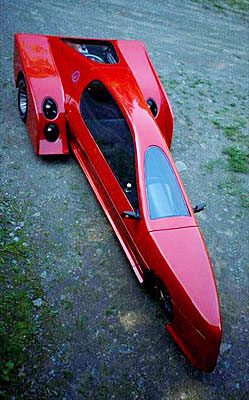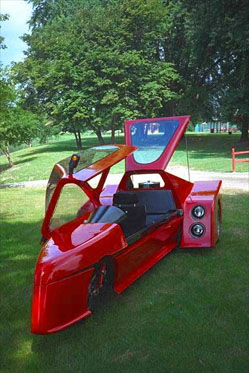Acceleration
The Vig prototype weighed in at 1,480
pounds -- 70 pounds lighter than an Indy car (which requires
a minimum weight of 1,550 pounds). With a very low pounds-per-horsepower
ratio, and 95% of the vehicle weight on the rear drive tires
during maximum acceleration, the performance is phenomenal. Its
acceleration is like a street-legal dragster. It's quicker off
the line than a Ferrari F-40 or F-50, a MacLaren F-1 road car,
or any other limited production exotic.
Cornering and Handling
With a very low center of gravity and
most of the weight over the two widely-spaced rear drive tires
(the only tires that can handle the transverse cornering forces),
and a very low polar moment of inertia, cornering is incredible.
The maximum theoretical tip-over limit is calculated to be 3.27
lateral "g", so the Vig will slide on dry pavement
with street tires long before it reaches its tip-over limit.
Our original design, the TriVetteTM
that was designed in 1974, actually out cornered a Corvette of
that time by 10% (verified by independent testing by an enthusiast
magazine). And, it still had a 0.5 "g" safety margin
before reaching the tip-over limit. Later testing by the Department
of Transportation showed the TriVette to be one of the most stable
and best handling vehicles they had tested. It out cornered and
out handled virtually all four-wheeled production vehicles. Their
conclusion was that three-wheeled vehicles can corner and handle
just as well as four-wheeled vehicles if the physics are done
correctly. Also, the very low polar moment of inertia yields
very quick transient responses to steering inputs.
Braking
As incredible as the acceleration and
cornering capabilities are, the most astounding capability of
the Vigillante is its braking performance. The Vigillante will
stop at 1 "g" (with high performance tires), but the
most amazing thing is how it handles under braking in slick road
conditions. Most of the weight is on the rear tires at static
loading, and under hard braking some weight is transferred to
the front tire. At 1 "g" deceleration, approximately
33% of the vehicle weight is on each tire, with approximately
66% of the vehicle weight on the rear tires, behind the center
of gravity (CofG). That means the vehicle is in the dynamically
stable condition.
![]() Continue?
Continue?

